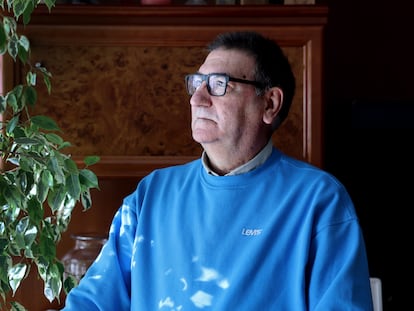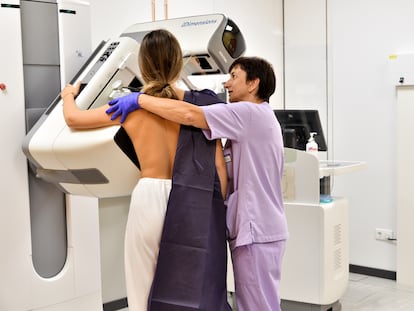Soraya Casla, specialist in oncological exercise: ‘Physical activity boosts survival by up to 40%’
The researcher outlines how to best prepare after a cancer diagnosis to cope with treatments and reduce the risks of relapse and other diseases
Soraya Casla, from Segovia, Spain, who holds a PhD in Physical Activity and Sports Sciences, began researching the benefits of physical exercise in cancer patients just over a decade ago. She discovered that, despite the evidence of its impact on increasing survival, preventing relapses and improving quality of life, in Spain it was not believed to be a therapeutic tool. Soroya traveled halfway around the world (United States, Canada, Denmark and Australia) to complete her training as a specialist in oncological exercise and on her return to Spain, in 2015, she began to complement the treatment of patients with personalized programs. Today she runs a specialized center and has just published Ante el cáncer, muévete (in English: Facing cancer, get moving).
Question. How did your project on cancer and exercise come about?
Answer. It came about after I realized that there was no real answer on oncological physical exercise for patients. During treatments, they experience a series of side effects for which it has already been demonstrated that the most effective for all patients is physical exercise. But it must be specific, adapted and individualized. This did not exist in Spain. After completing several international assistance projects and seeing how they worked in other countries, hospitals and institutions, I decided to develop my own project to help patients, to train them, to inform them, to do research and to make it as accessible as possible.
Q. What are the benefits of physical exercise for people with cancer?
A. It boosts survival and reduces the side effects of the treatments. We often relate it to nausea and fatigue, which is true, but what we observe is that the treatments also have a subsequent impact. They favor or open the door to the development of other cardiovascular diseases, hypertension issues, obesity, diabetes. These are diseases that can develop through a sedentary lifestyle and over the years, but increasingly appear in younger people. Exercise alleviates these side effects and, in the long term, we also reduce the risk of recurrence of cancer and other diseases.
Q. This conclusion is supported by a clinical study.
A. With Miguel Martín [professor of Medicine at the Complutense University of Madrid and head of the Medical Oncology Service at the Gregorio Marañón University Hospital] we conducted one of the first trials involving more than 200 patients over four years. When we published it, there was a lot of skepticism because it was believed that people could only do things at a very low intensity. We proved that exercise that combines high intensity and moderate intensity improves all physiological aspects: it increases muscle mass, improves the capacity to produce energy, and enhances the circulatory and cardiovascular system. And it was tolerated by patients both during and after chemotherapy.
Q. Is there a general pattern, or is each cancer and each patient different?
A. There is an exercise protocol that we individualize according to the patient’s level, the stage of the disease and the side effects or functional limitations. A patient who has exercised all their life, even if they are undergoing treatment, must continue. Other people who have never done physical exercise have to start by walking for five minutes. The stage of the disease is also taken into account. The recommendations are not the same for a person who is undergoing chemotherapy, radiation therapy, hormonal treatment or who has finished. This requires us to be trained and well-informed in order to know what the physiological changes may be and how we have to adapt the intensity of the program accordingly. And finally, specific functional limitations are considered. Having your entire breast and lymph nodes removed or having a pouch because you have had colon cancer or abdominal surgery is not the same thing. These circumstances lead to more specific limitations. In the book, I give specific recommendations based on all these aspects so that everyone can have access to true and scientific information about what the benefits of exercise are and what people can do.
“Walking may be the beginning, but it is not the end.”
Q. Walking is not enough?
A. Many studies tell us that only walking does not produce the changes we need. It is very important to start with that when you are healthy, because it helps you keep healthy. But, when we have to recover, we require a much more complex strategy. In the case of cancer, it is not only at the metabolic level. We also need to generate new neuronal connections, which are lost due to the treatments, and improve functionality and mobility. We must develop as complete a guide as possible. Walking may be the beginning, but it is not the end. We must progressively increase and include strength and balance cardiovascular exercise to ensure that it is complete and it really improves health in a comprehensive way because the deterioration caused by the treatments is much more global. It is also important to keep up the motivation. When a person comes to the center, we want to surprise them every day.
Q. How many times and for how long should you exercise per week?
A. According to the World Health Organization, ideally three days. Each session should last between 35 minutes and an hour and a quarter. We usually do between 50 and 75 minutes, allowing for breaks, gentle exercises and stretching.
Q. Before or after treatment?
A. People who start exercising before treatment tolerate it better and the side effects are milder. They get much less fatigued, have far less nausea and diarrhea, and feel less need to stay in bed due to excessive fatigue.
Q. And once it has been overcome?
A. You have to keep exercising. People who exercise during treatments and stop afterwards tend to return to the levels they were at before or just after chemotherapy, below normal. Staying active is necessary to preserve long-term benefits and prevent disease and physiological changes. One of the most problematic side effects is heart failure, which can develop after 10 to 15 years. People who exercise can lower the likelihood of heart failure by up to 40%.
Q. Does it boost survival?
A. Patients who do physical exercise after diagnosis increase their survival chances by 30% to 40%. The probability of having cancer again or developing second tumors and also other cardiac conditions or diabetes or metabolic problems is reduced. Physical exercise helps them live longer and better. It has been demonstrated in the cancers with the highest incidence, like breast or colon cancer. With other tumors, it is not that it does not happen, but we do not know if it happens because we do not have such extensive or high-quality studies.
Q. How does the sequence from exercise to benefits unfold?
A. High intensity, which can be achieved through strength or cardiovascular exercises, has cardiac benefits. We combine them with others for nerve regeneration, which is also very important. When you introduce high intensity, the cell realizes that it is unable to keep up with the body, it adapts and begins to mobilize a series of enzymes and proteins to generate energy in the mitochondria. That can only be achieved through high-intensity blocks. But the body needs to maintain those energy factories and to teach them to produce energy. If it does not use them, it is going to eliminate them. Here, moderate intensity plays an integral role, because it is the type that helps and drives the mitochondria to be functional. When they work well, they help preserve muscle, improve peripheral irrigation and enhance fat expenditure. This prevents other diseases.
“Walking every day at a steady pace for an hour helps to prevent tumors. But the exercise we do every day, at work or to commute, is not enough. You have to do something extra.”
Q. Exercise helps during and after cancer. Does it also prevent cancer?
A. Physical exercise has been linked to the prevention of some 26 types of tumors, but it must meet the recommendations of the World Health Organization, which is to do a minimum of 150 minutes of moderate exercise per week. But high intensity is not as important here. Even walking every day at a steady pace for an hour helps to prevent tumors. But the exercise we do every day, at work or to commute, is not enough. You have to do something extra, which means going out every day to walk for 30, 40 or 50 minutes and doing another type of activity to complement it.
Q. Why is exercise not incorporated into cancer treatment protocols?
A. In 2010, I had to go abroad to learn about oncological exercise because there was nothing here. However, I believe that the perception of health has changed significantly and nowadays more and more oncologists are recommending physical exercise. Indeed, many of my patients come to me because their physiotherapists, oncologists or oncology nurses have recommended that they should do physical exercise both during and after treatment. But we must continue to educate and inform and support patients and clinicians alike.
Sign up for our weekly newsletter to get more English-language news coverage from EL PAÍS USA Edition
Tu suscripción se está usando en otro dispositivo
¿Quieres añadir otro usuario a tu suscripción?
Si continúas leyendo en este dispositivo, no se podrá leer en el otro.
FlechaTu suscripción se está usando en otro dispositivo y solo puedes acceder a EL PAÍS desde un dispositivo a la vez.
Si quieres compartir tu cuenta, cambia tu suscripción a la modalidad Premium, así podrás añadir otro usuario. Cada uno accederá con su propia cuenta de email, lo que os permitirá personalizar vuestra experiencia en EL PAÍS.
¿Tienes una suscripción de empresa? Accede aquí para contratar más cuentas.
En el caso de no saber quién está usando tu cuenta, te recomendamos cambiar tu contraseña aquí.
Si decides continuar compartiendo tu cuenta, este mensaje se mostrará en tu dispositivo y en el de la otra persona que está usando tu cuenta de forma indefinida, afectando a tu experiencia de lectura. Puedes consultar aquí los términos y condiciones de la suscripción digital.
More information
Archived In
Últimas noticias
Most viewed
- Sinaloa Cartel war is taking its toll on Los Chapitos
- Oona Chaplin: ‘I told James Cameron that I was living in a treehouse and starting a permaculture project with a friend’
- Reinhard Genzel, Nobel laureate in physics: ‘One-minute videos will never give you the truth’
- Why the price of coffee has skyrocketed: from Brazilian plantations to specialty coffee houses
- Silver prices are going crazy: This is what’s fueling the rally











































